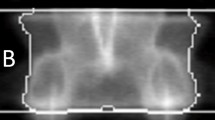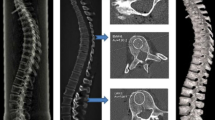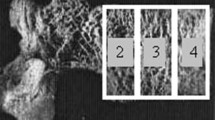Abstract
Purpose
A damaged vertebral body can exhibit accelerated ‘creep’ under constant load, leading to progressive vertebral deformity. However, the risk of this happening is not easy to predict in clinical practice. The present cadaveric study aimed to identify morphometric measurements in a damaged vertebral body that can predict a susceptibility to accelerated creep.
Methods
A total of 27 vertebral trabeculae samples cored from five cadaveric spines (3 male, 2 female, aged 36 to 73 (mean 57) years) were mechanically tested to establish the relationship between bone damage and residual strain. Compression testing of 28 human spinal motion segments (three vertebrae and intervening soft tissues) dissected from 14 cadaveric spines (10 male, 4 female, aged 67 to 92 (mean 80) years) showed how the rate of creep of a damaged vertebral body increases with increasing “damage intensity” in its trabecular bone. Damage intensity was calculated from vertebral body residual strain following initial compressive overload using the relationship established in the compression test of trabecular bone samples.
Results
Calculations from trabecular bone samples showed a strong nonlinear relationship between residual strain and trabecular bone damage intensity (R2 = 0.78, P < 0.001). In damaged vertebral bodies, damage intensity was then related to vertebral creep rate (R2 = 0.39, P = 0.001). This procedure enabled accelerated vertebral body creep to be predicted from morphological changes (residual strains) in the damaged vertebra.
Conclusion
These findings suggest that morphometric measurements obtained from fractured vertebrae can be used to quantify vertebral damage and hence to predict progressive vertebral deformity.






Similar content being viewed by others
References
Lee SH, Kim ES, Eoh W (2011) Cement augmented anterior reconstruction with short posterior instrumentation: a less invasive surgical option for Kummell’s disease with cord compression. J Clin Neurosci 18:509–514. https://doi.org/10.1016/j.jocn.2010.07.139
Muratore M, Ferrera A, Masse A, Bistolfi A (2018) Osteoporotic vertebral fractures: predictive factors for conservative treatment failure. Syst Review Eur Spine J 27:2565–2576. https://doi.org/10.1007/s00586-017-5340-z
Luo J, Dolan P, Adams MA, Annesley-Williams DJ, Wang Y (2020) A predictive model for creep deformation following vertebral compression fractures. Bone 141:115595
O’Callaghan P, Szarko M, Wang Y, Luo J (2018) Effects of bone damage on creep behaviours of human vertebral trabeculae. Bone 106:204–210
Kopperdahl DL, Pearlman JL, Keaveny TM (2000) Biomechanical consequences of an isolated overload on the human vertebral body. J Orthop Res 18:685–690. https://doi.org/10.1002/jor.1100180502
Hernandez CJ, Lambers FM, Widjaja J, Chapa C, Rimnac CM (2014) Quantitative relationships between microdamage and cancellous bone strength and stiffness. Bone 66:205–213. https://doi.org/10.1016/j.bone.2014.05.023
Larrue A, Rattner A, Peter ZA, Olivier C, Laroche N, Vico L, Peyrin F (2011) Synchrotron radiation micro-CT at the micrometer scale for the analysis of the three-dimensional morphology of microcracks in human trabecular bone. PLoS ONE 6:e21297. https://doi.org/10.1371/journal.pone.0021297
Zeytinoglu M, Jain RK, Vokes TJ (2017) Vertebral fracture assessment: Enhancing the diagnosis, prevention, and treatment of osteoporosis. Bone 104:54–65
Takahashi S, Hoshino M, Takayama K, Iseki K, Sasaoka R, Tsujio T, Yasuda H, Sasaki T, Kanematsu F, Kono H, Toyoda H, Nakamura H (2016) Predicting delayed union in osteoporotic vertebral fractures with consecutive magnetic resonance imaging in the acute phase: a multicenter cohort study. Osteoporos Int 27:3567–3575. https://doi.org/10.1007/s00198-016-3687-3
Luo J, Annesley-Williams DJ, Adams MA, Dolan P (2017) How are adjacent spinal levels affected by vertebral fracture and by vertebroplasty? A biomechanical study on cadaveric spines. Spine J 17:863–874
Luo J, Pollintine P, Gomm E, Dolan P, Adams MA (2012) Vertebral deformity arising from an accelerated “creep” mechanism. Eur Spine J 21:1684–1691. https://doi.org/10.1007/s00586-012-2279-y
Dolan P, Earley M, Adams MA (1994) Bending and compressive stresses acting on the lumbar spine during lifting activities. J Biomech 27:1237–1248
Yamamoto E, Paul Crawford R, Chan DD, Keaveny TM (2006) Development of residual strains in human vertebral trabecular bone after prolonged static and cyclic loading at low load levels. J Biomech 39:1812–1818
Sato K, Kikuchi S, Yonezawa T (1999) In vivo intradiscal pressure measurement in healthy individuals and in patients with ongoing back problems. Spine (Phila Pa 1976) 24:2468–74. Doi: https://doi.org/10.1097/00007632-199912010-00008
Adams MA, Dolan P, Hutton WC (1986) The stages of disc degeneration as revealed by discograms. J Bone Joint Surg Br 68:36–41
Pollintine P, Dolan P, Tobias JH, Adams MA (2004) Intervertebral disc degeneration can lead to "stress-shielding" of the anterior vertebral body: a cause of osteoporotic vertebral fracture? Spine (Phila Pa 1976) 29:774–82
Green TP, Allvey JC, Adams MA (1994) Spondylolysis. Bending of the inferior articular processes of lumbar vertebrae during simulated spinal movements. Spine (Phila Pa 1976) 19:2683–91
Adams MA (1995) Mechanical testing of the spine. An appraisal of methodology, results, and conclusions. Spine (Phila Pa 1976) 20:2151–6
Wilke HJ, Neef P, Caimi M, Hoogland T, Claes LE (1999) New in vivo measurements of pressures in the intervertebral disc in daily life. Spine (Phila Pa 1976) 24:755–62
McKiernan F, Jensen R, Faciszewski T (2003) The dynamic mobility of vertebral compression fractures. J Bone Miner Res 18:24–29. https://doi.org/10.1359/jbmr.2003.18.1.24
Adams MA, Bogduk N, Burton K, Dolan P (2002) The biomechanics of back pain. Churchill Livingstone, Edinburgh
Rimnac CM, Petko AA, Santner TJ, Wright TM (1993) The effect of temperature, stress and microstructure on the creep of compact bovine bone. J Biomech 26:219–28
Lu X, Yang J, Zhu Z, Lv X, Wu J, Huang J, Yu L, Wen Z, Luo J, Wang Y (2020) Changes of the adjacent discs and vertebrae in patients with osteoporotic vertebral compression fractures treated with or without bone cement augmentation. Spine J 20:1048–55
Lee SH, Lee SG, Son S, Kim WK (2014) Influence of Compression Ratio Differences between Magnetic Resonance Images and Simple Radiographs on Osteoporotic Vertebral Compression Fracture Prognosis after Vertebroplasty. Korean J Spine 11:62–7. Doi:shttps://doi.org/10.14245/kjs.2014.11.2.62
Chen YJ, Lo DF, Chang CH, Chen HT, Hsu HC (2011) The value of dynamic radiographs in diagnosing painful vertebrae in osteoporotic compression fractures. AJNR Am J Neuroradiol 32:121–124. https://doi.org/10.3174/ajnr.A2233
Toyone T, Tanaka T, Wada Y, Kamikawa K, Ito M, Kimura K, Yamasita T, Matsushita S, Shiboi R, Kato D, Kaneyama R, Otsuka M (2006) Changes in vertebral wedging rate between supine and standing position and its association with back pain: a prospective study in patients with osteoporotic vertebral compression fractures. Spine (Phila Pa 1976) 31:2963–6
Funding
This work was supported by research grants from Sir Halley Stewart Trust and Action Medical Research, UK [Grant numbers 0994, 1083, and 1161].
Author information
Authors and Affiliations
Contributions
JL contributed to conceptualization, methodology, formal analysis, writing—original draft preparation. PD contributed to methodology, writing—reviewing and editing. MAA contributed to methodology, writing—reviewing and editing. DJAW contributed to conceptualization, writing—reviewing and editing.
Corresponding author
Ethics declarations
Conflict of interest
The authors have no conflicts of interest to declare that are relevant to the content of this article.
Availability of data and material
The datasets generated during and/or analysed during the current study may be available from the authors on reasonable request.
Code availability
The code generated during the current study is available from the authors on reasonable request.
Ethics approval
This research has been conducted using experimental data from previous studies which had received ethics approval.
Consent to participate
Not applicable.
Consent for publication
Not applicable.
Additional information
Publisher's Note
Springer Nature remains neutral with regard to jurisdictional claims in published maps and institutional affiliations.
Appendix
Appendix
See Figures.
7,
The relationship between increased vertebral creep rate (\(\mathrm{ln}{\dot{\varepsilon }}_{c}-\mathrm{ln}{\dot{\varepsilon }}_{0}\)) and vertebral damage [\(-\mathrm{ln}\left(1-\omega \right)]\) based on data represented in Fig. 7. Mechanical test data were from 25 vertebral bodies. \({\dot{\varepsilon }}_{0}\) is the vertebral creep rate before damage, \({\dot{\varepsilon }}_{c}\) is the vertebral creep rate after damage, and \(\omega \) is the damage intensity derived from residual strain measured in the ramp loading/unloading cycle performed after compressive overload
8,
9,
The relationship between increased vertebral creep rate (\(\mathrm{ln}{\dot{\varepsilon }}_{c}-\mathrm{ln}{\dot{\varepsilon }}_{0}\)) and vertebral damage [\(-\mathrm{ln}\left(1-\omega \right)]\) based on data represented in Figure 9. Mechanical test data were from 25 vertebral bodies. \({\dot{\varepsilon }}_{0}\) is the vertebral creep rate before damage, \({\dot{\varepsilon }}_{c}\) is the vertebral creep rate after damage, and \(\omega \) is the damage intensity derived from residual strain measured in the ramp loading/unloading cycle performed after compressive overload
10.
Rights and permissions
About this article
Cite this article
Luo, J., Dolan, P., Adams, M.A. et al. Morphometric measurements can improve prediction of progressive vertebral deformity following vertebral damage. Eur Spine J 31, 70–78 (2022). https://doi.org/10.1007/s00586-021-07013-w
Received:
Accepted:
Published:
Issue Date:
DOI: https://doi.org/10.1007/s00586-021-07013-w








